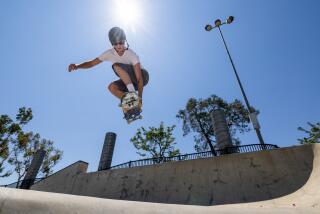20-SECOND TIMEOUT
- Share via
Question: Figure-skating jumps look alike. How do you tell the difference?
Answer: If you seldom watch baseball, you might be able to tell if a pitch is a ball or strike, but probably not if it’s a slider, fastball or sinker. If you know how to watch skating, you can identify more than if the skater manages to seat-dusting the ice.
The edge, or the angle of the skate’s blade, on takeoff and landing is key to jump identification. There are two categories of jumps among the six individual types: the axel, salchow and loop are edge jumps; the toe loop, flip and lutz are toe jumps. Edge jumps take off from the edge of the blade, and toe jumps take off by tapping the toe of the blade onto the ice for lift. Keen observers can detect which edge -- the inside or the outside of the blade -- provides thrust for edge jumps and, for all jumps, which edge meets the ice on landing.
Toe jumps generally are easier than edge jumps because the additional thrust fuels the rotations in the air. But mastering the timing of the tap is tricky, so skaters generally learn edge jumps before toe jumps.
Unsuccessful jumps most commonly result from either a failure to complete a full rotation, rendering the landing edge insecure, or an untimely exit of the nonlanding leg from rotation, called “free-leg checkout,” which creates downward momentum. Bottom line: Bottom bites ice.
-- Ellen Alperstein


